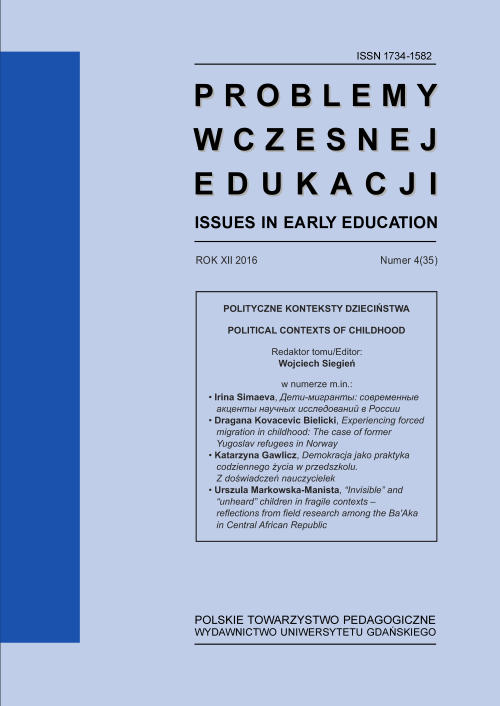Vietnamese immigration in Poland: issues of education and integration for children
Słowa kluczowe:
immigration, issues in education with immigration, Vietnamese children, issues of education and integrationAbstrakt
This paper investigates the issues of education and integration conditions for Vietnamese immigrants’ children in Poland. These points of interest were primarily treated as the additional research connected with our teaching practices. It was conducted as an empirical study with three non-standardised interviews with the families, informal observations, and group discussions. Regardless of the limitation of a perhaps not significantly substantial range of data, the study led to the outlining of some concerns connected with the process of education and integration of the children in these Vietnamese families. The main four findings which are related to the research question are: the cultural differences and expectations of the parents, the language barriers of the parents, the typical stereotypes of educating children at home, and the conflicts of self-identification in the future. The research implied that children from all the immigrant groups should be assessed as to their growth as well as to the quality of their adaptation into the society.
Downloads
Bibliografia
Aider J.K. (2015), The Impact of Discrimination on the Early Schooling Experiences of Children from Immigrant Families. Washington, DC, Migration Policy Institute.
Allan L. (1989), Immigration and multiculturalism. “Politics”, 24(2).
Berger R., Weiss T. (2003), Immigration and Posttraumatic Growth-A Missing Link. “Journal of Immigrant & Refugee Services”, 1(2).
Birman D., Poff M. (2011), Intergenerational differences in acculturation. Encyclopedia on Early Childhood Development.
Cline T., Crafters S., Abreu de G., O’Dell L. (2009), Changing families, changing childhoods: changing schools? “Pastoral Care in Education”, 27(1).
Campani G. (1993), Immigration and racism in southern Europe: The Italian case. “Ethnic and Racial Studies”, 16(3).
Cardoso J.C. (2007), Immigration to Portugal. “Journal of Immigrant & Refugee Studies”, 4(4).
Carens H.J. (2014), An overview of the ethics of immigration. “Critical Review of International Social and Political Philosophy”, 17(5).
Celna I. (2016), Wietnamczycy ukryci między paletami. W skrytce podróżowało 13 osób. Retrieved on October 21, 2016 from http://www.tvp.info/27427334/wietnamczycy-ukryci-miedzy-paletami-w-skrytce-podrozowalo-13-osob.
Corson P., Bernhard K.J., Gonzalez-Mena J. (1998). Culturally situated explorations of child development: A home visit project for prospective early childhood teachers. “Journal of Early Childhood Teacher Education”, 19(3).
Drachman D., Shen Ryan A. (1991), Immigrants and refugees. In: A. Gitterman (Ed.), Social work practice with vulnerable populations (618–646). NY, Columbia University Press.
Gregor N.M., Green C. (2011), Welcoming the World’s Children: Building Teachers’ Understanding of Immigration through Writing and Children’s Literature. “Childhood Education”, 87(6).
Hu J., Torr J., Whiteman P. (2014), Parents don’t want their children to speak their home language’: how do educators negotiate partnerships with Chinese parents regarding their children’s use of home language and English in early childhood settings? “Early Years: An International Research Journal” 34(3).
Jensen T.B. (2007), Understanding Immigration and Psychological Development. “Journal of Immigrant & Refugee Studies”, 5(4).
Kimberlin E.S. (2009), Synthesizing Social Science Theories of Immigration. “Journal of Human Behavior in the Social Environment”, 19(6).
Kong D.S., Yoon K.W., Yu S.Y. (2010), The Social Dimensions of Immigration in Korea. “Journal of Contemporary Asia”, 40(2).
Marsiglia F.F., Kulis S., Fitz Harris B., Becerra D. (2009), Acculturation Gaps and Problem Behaviors among U.S. Southwestern Mexican Youth. “Social Work Forum” (New York, N.Y.), 42–43.
Mogro-Wilson C. (2008), The influence of parental warmth and control on Latino adolescent alcohol use. “Hispanic Journal of Behavioral Sciences”, 30(1).
Nguyen D.K., Siciarek M. (2015), Badanie Dostępności Wydziału Cudzoziemców Urzędu Wojewódzkiego W Gdańsku. Report from a research w ramach projektu „Wspieranie Integracji i Aktywizacji Cudzoziemców”, współfinansowanego ze środków Europejskiego Funduszu na Rzecz Integracji Obywateli Państw Trzecich (EFI) oraz budżetu państwa i w ramach projektu „Program Przeciwdziałania Dyskryminacji Cudzoziemców”, realizowanego w ramach programu Obywatele dla Demokracji, finansowanego z Funduszy EOG.
Nowicka E. (2014), Young Vietnamese generation in Poland: caught between the rock and a hard place. “Przegląd Zachodni”, 2.
Shields M.K., Behrman R.E. (2004), Children of immigration families: analysis and recommendations. “The Future of Children”, 14(2).
Tienda M., Haskins R. (2011), Immigrant children: Introducing the issue. “The Future of Children”, 21(1).
Tedeschi R.G., Park C.L., Calhoun L.G. (1998), Posttraumatic growth: Positive transformations in the aftermath of crisis. Mahwah, NJ, Lawrence Erlbaum Associates Publishers.
Toppelberg C.O., Collins B.A. (2010), Language, culture, and adaptation in immigrant children. “Child & Adolescent Psychiatric Clinics of North America”, 19(4).
Weiner M. (1995), The Global Migration Crisis: Challenges to States and to Human Rights, New York, Longman.
Witmer T.A., Culver S.M. (2001), Trauma and resilience among Bosnian refugee families: A critical review of the literature. “Journal of Social Work Research”, 2(2).

 Uniwersyteckie Czasopisma Naukowe
Uniwersyteckie Czasopisma Naukowe





